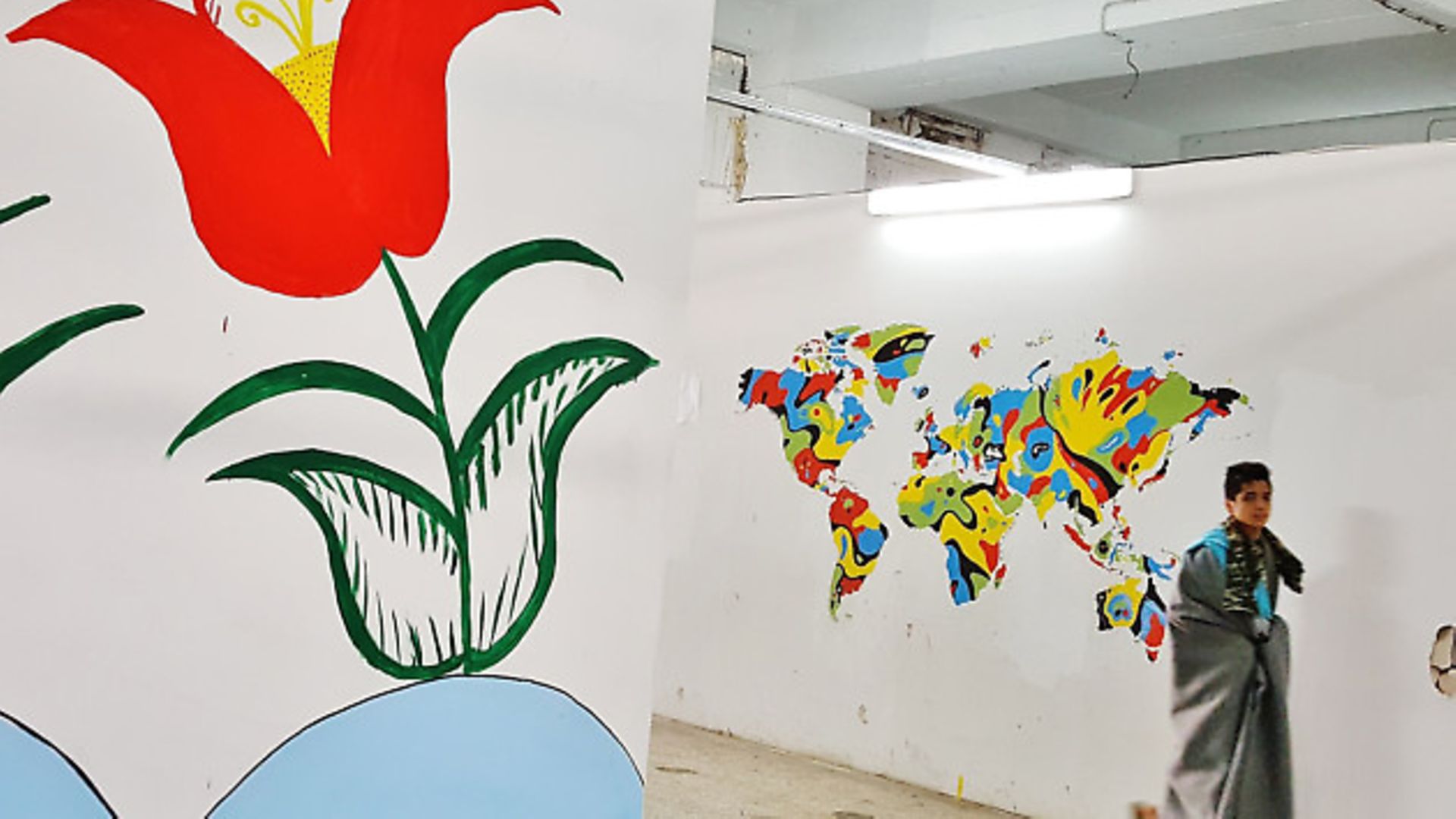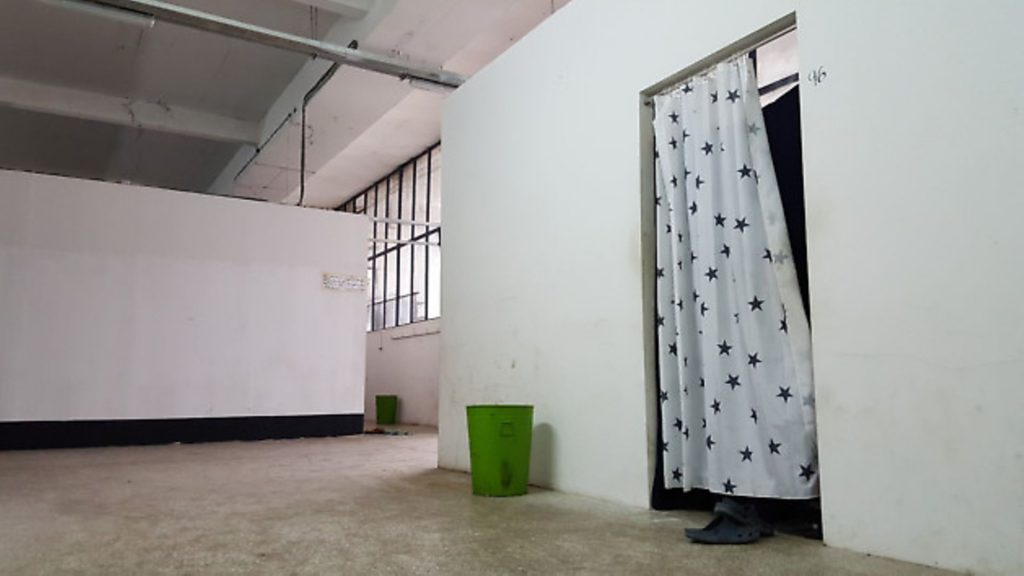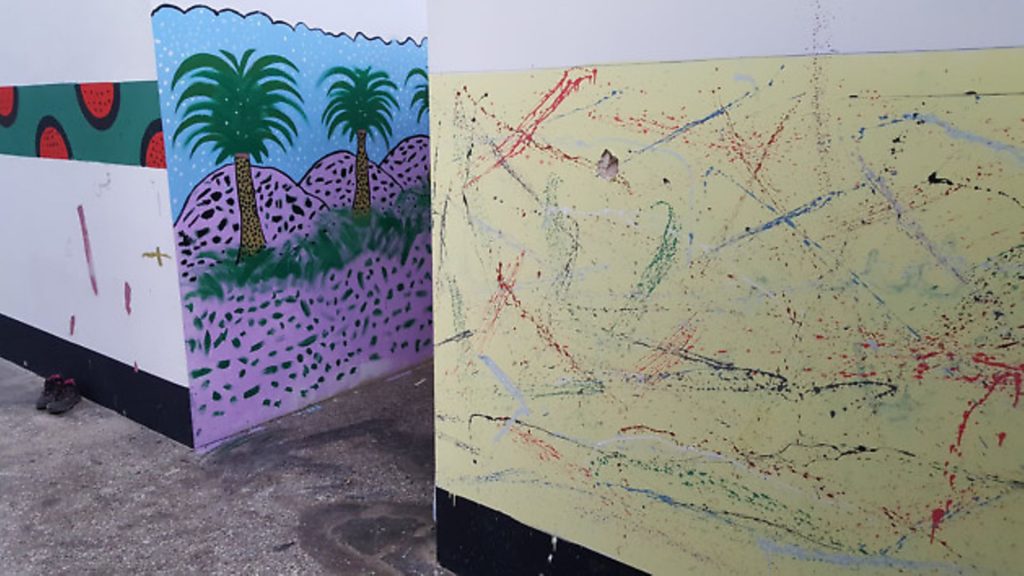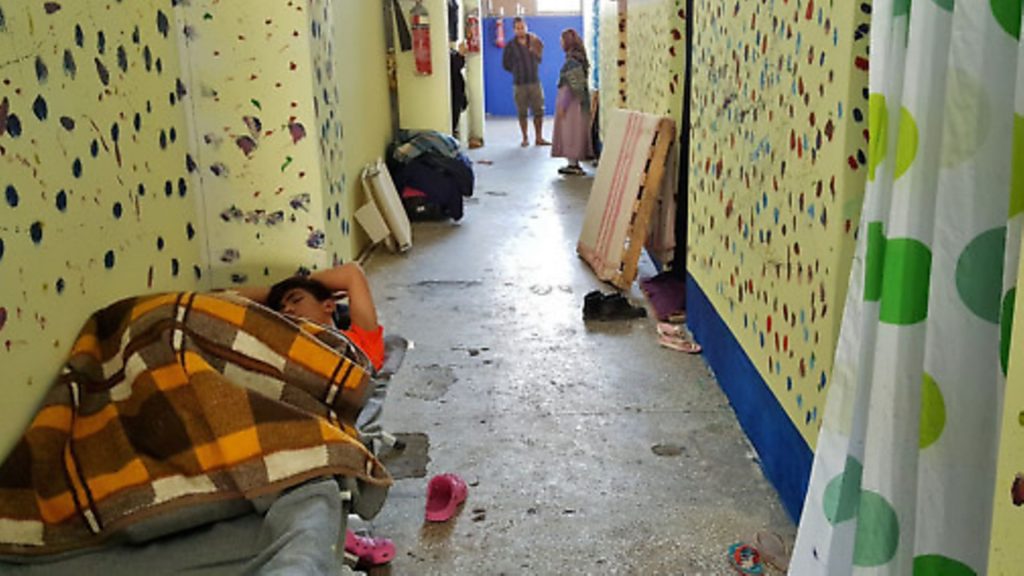
These refugees used freedom of expression take back control

Distressed by the tragedies unfolding from the Mediterranean migrant crisis, author Danny Scheinmann decided to do something about it – and found himself caught up in a story which helped, in a most unusual way, to bring dignity, pride and empowerment to some of the refugees
When we drove through the gates of Oinofyta refugee camp in to the grounds of a disused warehouse an hour north of Athens and I saw the crowds of men spilling out of the crumbling building, the rows of tents pitched on the adjacent wasteland and the tiny kids running around in the rubble, I felt apprehensive about what I had signed up for. We had been asked by the camp director, Lisa Campbell, to help the residents ‘beautify’ the camp. In other words, paint it. I’m a novelist and actor, I’ve probably painted two walls in my entire life and that was enough to put me off. I once bought a DIY book called ‘You can do it’. My son defaced the cover so it read ‘You can’t do it’. That pretty much sums me up.
For a couple of years I had been feeling helpless in the face of the humanitarian crisis unfolding in Afghanistan and Syria. But when, on September 2 2015, Alan Kurdi was washed up on a beach in Bodrum, and I saw the now famous photograph of the three-year-old boy lying face down at the water’s edge in his navy blue shorts and red T shirt I felt shamed by my inaction. In my latest novel The Half Life of Joshua Jones a girl tells the protagonist: ‘People like you live your whole lives under anaesthetic.’ I may as well have written those words to myself.

My parents are both refugees. My father escaped Nazi Germany on the Kindertransport aged six and was raised by a poor family in Salford. My mother escaped Hungary in 1956 when the Russian tanks rolled in to Budapest.
So when St Ethelburga’s Centre for Reconciliation and Peace advertised for 10 volunteers to work on a refugee project I felt duty bound to apply. Of course, at that stage, no one knew anything about painting and most of the volunteers were as uncomfortable about the prospect as I was, but how difficult could it be to whitewash some walls?
We got out of the cars. Residents stared at us from afar. Children began to circle us, checking us out. I watched a tiny girl of two or three dig a hole in the gravel with her hands and ferry stones in a tissue to a secret pile a few yards away. There are around 700 people in Oinofyta of whom 250 are minors. The majority of the residents are Afghan and have been in Greece for an average of ten months with little prospect of moving on. Half live outside in the tents and half inside where rows of hastily constructed partitioned spaces barely big enough for a double bed and table serve as their homes.
These ‘cells’ have no roofs, no windows and only a blanket or sheet as a door. At night the smallest sounds echo around the hall. No conversation is private. When it rains the water leaks in and floods the floor.

I was a little sceptical about the idea of painting. Surely there were more pressing needs? But Lisa had a clear vision of what she wanted us to do. Lisa is a no-nonsense American woman with a big heart. She had come six months earlier as a volunteer for a charity called Do Your Part and ended up running the camp. She was also a grandmother, which made her all the more impressive to me.
The following morning we bought around 50 litres of paint and a bag of brushes and rollers and the painting began. The army of children who crowded round us at every moment were soon gainfully employed in putting their hand prints on a wall, but the adults were far slower to get involved. One or two got in to it straight away. A young Afghan mother started to draw giant flowers outside her room and within a couple of days her walls were vibrant with colour. I hadn’t considered that people might start painting murals!
At one point I was trying to draw a straight line across a wall and put up some tape when a tall man in his 40s tapped me on the shoulder and took my pencil and tape. It turns out he was a civil engineer and should have been building bridges not drawing lines but he was delighted to show me how to do it properly.
Later I met another engineer, his wife was a university lecturer. Twice he had been in targeted bomb attacks from the Taliban who despise intellectuals. In Afghanistan he had been wealthy with two cars and a large house. I met doctors, teachers, craftsmen and artists at Oinofyta. Many of the refugees who make it to Europe are middle class professionals who used their savings to pay for their crossings.

Unlike the Syrians, the Afghans have no legal status in the EU and are under constant threat of deportation, despite the risk of being killed by the Taliban.
Little by little, more people started to pick up brushes until by the end of the second day we had ran out of everything. I went back to the paint shop to stock up, this time buying some thinner art brushes. On day three we arrived to find someone had whitewashed the kids handprint wall.
Some residents thought it was messy and wanted to make it more ‘beautiful’, a challenge for those of us who have our walls covered with kids drawings and think it’s lovely.
Meanwhile a middle-aged Pakistani man who had never painted in his life had been up half the night drawing a beautiful picture of his home, with a river, a house and a Pakistani flag.
A young man approached me very quietly with a child’s colouring book and showed me a drawing of a smiley fish that he’d coloured in crayon. He pointed to the wall. I said OK. We painted the wall blue for the sea and he copied a few fishes from his book.
It was so naive and lovely – as if he was making up for a lost childhood. It began to get chaotic. I’d bought thirty more brushes that morning and a few hundred euros of paint and everything was in use.
People were painting down every corridor outside their doors. Someone was painting the wall by the toilet. A larger Pakistani flag appeared on a new wall. And Afghan flags popped up in corridors outside doors.
I couldn’t mix paint fast enough. Lisa had taken half the volunteers to help her sort through a backlog of clothes in the distribution centre. Two of the remaining paint team tried to occupy the hundreds of tiny kids who just wanted to paint everything everywhere. We were losing control of who had what and who was doing what. Every time I stepped out of the secure paint room someone else wanted me to go back in and get another colour. The sheer energy of it was extraordinary. These were the same people who asked us for roofs, hot water and oil on our first day and now they wanted red and blue and green. It was unruly, fantastic and chaotic.
There was paint all over the place and then when I finally had a moment to walk around I became aware of a large group of young men drawing a large Afghan flag opposite the Pakistani wall. And at that moment I knew we were in trouble.
We didn’t want the central avenue to turn in to a competition of who could paint the biggest flag, and yet how lovingly had this gentle Pakistani man painted the idyll of his home. The thought of painting over their flags and denying them their identity when they had already been denied any legal status made us feel sick.
Some of the residents were angry at the prospect. We had been operating in a bubble of naivety but this outpouring of creative energy had now revealed deeper issues. There was a vigorous discussion about whether flag painting was provocative or a natural assertion of pride.
That night I didn’t sleep well. I feared the worst but in the morning a compromise was proposed to which all parties agreed. They would paint over their flags and there would be one flag wall containing the six flags of the various nations housed in the camp – all of equal size.
The painting was spreading down every corridor in to every corner of the building. Residents inspired by each other were coming up with ever more elaborate designs.
Almost no wall was left uncovered. Every day I bought more and more paint until the paint shop had literally run out and there were around 100 brushes in use. People painted over night so every morning brought surprises.
On our final day, the inside of the warehouse looked magnificent and I realised that this project had been so much more than about painting. It was about dignity, pride, empowerment and freedom of expression.
Lisa said people who had been idle were active, people who didn’t talk were discussing colours and different nationalities that didn’t normally mix were working side by side. Every day refugees receive handouts; it is disempowering and humiliating, but for one week in November they had taken back control.
The place had been alive with creative excitement. We knew we had made a difference when an old man who had sat in judgment snorting at this ridiculous project for the whole week suddenly picked up a brush on the last day and painted his walls. Perhaps the biggest change though was inside myself. Taking action was life changing. Doing good has done me good.
Danny Scheinmann is the author of Random Acts of Heroic Love. His latest novel The Half Life of Joshua Jones is published by Unbound.
To donate to Oinofyta click here.
A photographic exhibition will take place in February at St Ethelburga’s Centre for Reconciliation and Peace, 78 Bishopsgate, London EC2N 4AG
Warning: Illegal string offset 'link_id' in /mnt/storage/stage/www/wp-includes/bookmark.php on line 357
Notice: Trying to get property 'link_id' of non-object in /mnt/storage/stage/www/wp-includes/bookmark.php on line 37






